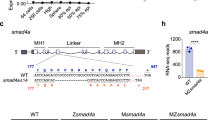Abstract.
Bone morphogenetic protein-4 (BMP-4) and its Drosophila ortholog, decapentaplegic (Dpp), are multifunctional developmental regulators. Both gain-of-function and loss-of-function studies demonstrate that the biological activity and signaling range of these morphogens must be strictly regulated to ensure normal embryonic patterning. BMP-4 and Dpp are produced from inactive precursors that are proteolytically cleaved, following which the active ligand is secreted into the extracellular space. Binding of BMP-4 or Dpp to its cognate receptor leads to phosphorylation of intracellular signal-transducing Smad proteins that then form hetero-oligomers, translocate to the nucleus and modulate transcription of target genes. Recent studies have shown that the BMP signal transduction cascade can be modulated at every step of this process.
Similar content being viewed by others
Author information
Authors and Affiliations
Additional information
Received 20 December 1999; accepted 18 February 2000
Rights and permissions
About this article
Cite this article
Nakayama*, T., Cui*, Y. & Christian**, J. Regulation of BMP/Dpp signaling during embryonic development . CMLS, Cell. Mol. Life Sci. 57, 943–956 (2000). https://doi.org/10.1007/PL00000736
Issue Date:
DOI: https://doi.org/10.1007/PL00000736




